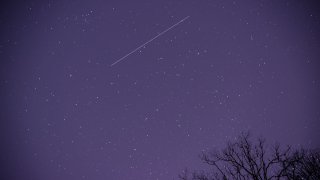
INTERNATIONAL STATION FLY-BYS
The International Space Station will make flybys across the North Texas sky this month. The ISS appears as a fast-moving star across the night sky.

The International Space Station rotates around the Earth at a speed of 17,500 mph. The ISS rotates about its center of mass at a rate of about 4 degrees per minute so that it will complete a full rotation once per orbit. This allows it to keep its belly towards the Earth. One revolution around the planet takes about 90 minutes (16 per day).
Get DFW local news, weather forecasts and entertainment stories to your inbox. Sign up for NBC DFW newsletters.
Also, the International Space Station lies at an altitude of 250 miles above the Earth. By the way, that is 1.32 million feet. Most commercial airplanes fly between 33,000 to 42,000 feet.
THE GEMINID METEOR SHOWER
The Geminid meteor shower occurs between November 19th to December 24th. The peak of this event will happen on the nights of December 14th and 15th.
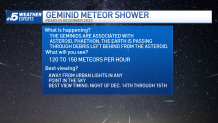
The Geminids are associated with Phaethon, an asteroid that may have undergone a collision with another object in the distant past to produce the stream of particles that Earth runs into — creating the meteor shower.
The asteroid behaves like a comet and orbits the Sun every 1.4 years. When Earth passes through the debris left behind by Phaethon, debris heats up as it enters the Earth's atmosphere creating bright bursts of light. Skywatchers can see 120 to 150 meteors per hour at peak times.
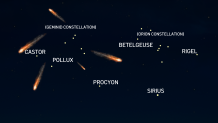
Gemini is fairly easy to spot in the night sky as it is located northeast of the Orion constellation, between the Taurus and Cancer constellations. The two brightest stars in the constellation, Castor and Pollux, represent the heads of the Gemini twins.
Weather Connection
Connecting you with your forecast and all the things that make North Texas weather unique.
The best time to view the Geminid meteor shower is around 2 a.m. local time when the shower's radiant is at its highest point in the sky. To best see the Geminid meteor shower, go to the darkest possible location, away from urban light pollution. You don't need any special equipment like telescopes or binoculars to view the event.
THE WINTER SOLSTICE
On December 21st at 9:27 p.m. CST., the season officially changes from fall to winter with the arrival of the winter solstice. This marks the shortest day of the year.
The sun is shining directly over the Tropic of Capricorn, located south of the equator. The Earth's tilt of 23.5° around the Sun causes seasons. On average, winter lasts for 89.0 days in the Northern Hemisphere. Places within the polar circle experience polar night during all or part of the winter season when the Sun does not rise at all.
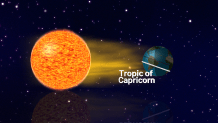
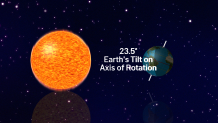
Although daylight hours increase during the winter months, temperatures will continue to fall in the Northern Hemisphere. This is because it takes time for the Earth to warm up, an effect known as seasonal lag.
With the passing of the winter solstice to the end of December, the Earth has traveled 584 million miles around the Sun. The Earth is moving at an orbital speed of 66,616 mph. This speed is fast enough to cover the planet's diameter in 7 minutes and the distance to the Moon in 4 hours.
THE MOON-JUPITER CONJUNCTION
On December 22nd at 8:20 a.m. CST., Jupiter will meet the Moon in the Aries constellation. With this conjunction happening after sunrise, the best time to observe will be before sunrise. The distance between the two objects will be too far to spot them at once via telescope, but you’ll easily see the conjunction with the naked eye or binoculars.
Jupiter's distance from the Earth varies from 336 million miles to 600 million miles.
THE LAST FULL MOON OF THE YEAR
The 13th and final full moon of 2023 will take place in December. The final full moon will rise in the evening sky of December 26th.
That moon, known as the "Cold Moon", gets its name for the frigid temperatures that begin to impact most of the Northern Hemisphere as winter begins on December 21st.
The December full moon is also known as the "Long Night Moon" that refers to the length of nights in the month. December features nearly 15 hours of darkness per night.
While there were 13 full moons in 2023, we won’t see that number again until 2026. Both 2024 and 2025 will only have one full moon per month, with the next “blue moon” occurring on May 31, 2026.
Also, a full moon won’t fall again on Christmas until 2034, representing the conclusion of a 19-year cycle.
MOON PHASES
Also, check out other phases of the moon this month.
On December 4th at 12:41 p.m. CST., the moon will be at apogee, its farthest from the Earth for this orbit at 251,249 miles.
On December 16th at 12:52 p.m. CST., the moon will be at perigee, it is closest to the Earth for this orbit at 228,603 miles.

Please enjoy these events happening in the night sky this month. Until then...Texans, keep looking up!



